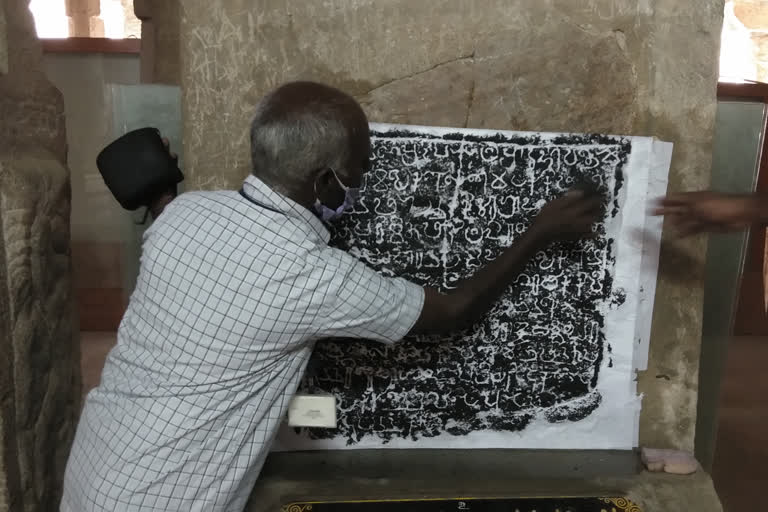Madurai: Inscriptions throw light on our past and remain the primary sources in the study of history. Tamil Nadu has the largest collections inscriptions found in the country. Now, for the first time, the entire range of inscriptions at the Meenakshi Amman Temple in Madurai has been compiled into a book. The book will contain details of all the wall inscriptions in the temple, including those from early centuries of the Christian era and Pandya kingdom. The famed ancient temple, a world heritage monument, has a total of about 410 inscriptions. Some of them were damaged by the vagaries of time. A dedicated team of archaeologists and epigraphists have painstakingly copied and printed them.
“So far Archaeological Survey of India (ASI) has copied and released only four inscriptions. Further, 60 more have been copied and released in English. Only now, the inscriptions in their entirety have been brought into print. The mammoth task took more than a year and was completed by end of August this year,” renowned archaeologist Dr. C Santhalingam said.
A cultural marker of the Tamils and a famed pilgrim centre for over 2000 years since the Sangam period, the iconic temple holds a special place in India. So are the inscriptions which provide interesting insights about ordinary people from various epochs and the kings who offered patronage to the temple.
Also Read: UP: ASI to commence campaign for registering antiques more than 100 years old
A piece of interesting information in one of the inscriptions relates to the protest by the palanquin bearers. “Once a palanquin bearer committed suicide by jumping off the Eastern tower of the temple, in protest against the withdrawal of land gifts to 64 palanquin bearers by the King. All of them had gathered at the Eastern tower and staged a protest, raising slogans. After their protest failed to elicit any response from the king, one among them climbed the tower and took the extreme step of ending his life by jumping off the tower,” says Dr. Santhalingam, further explaining that this incident took place during the reign of Vijayaranga Chokkanatha Nayak (1662-1682).
Of the 410 inscriptions, only 80 remain undamaged and most of them relate to land gifts by Kings the and contain the names of the Kings from various eras. The only exception is the ‘Vaigai Inscription’ as it was found close to the riverbed at Kuruvikkaran Salai in Madurai city. The 'Vaigai Inscription' belongs to CE 700. It was discovered by Prof. K V Raman in 1961. Some of the inscriptions contain details about a number of monthly festivals including the boat festival, a continuing traditional event.
“The temple has been in existence for over two millennia and there are numerous references to it in the Sangam period poetry compilations such as ‘Madurai Kanchi’ and ‘Paripaadal’. The ancient temple was built with brick and mortar, the more recent structure was built in the 13th century and expanded over the period, hosting temples for both Amman (South Indian godess of rain) and Lord Shiva. It was only since 1752 the deity's' name as Meenakshi gained popularity. Lord Shiva's name as Sundareswarar came to the popular lore only after 1898,” says Dr Santhalingam.
Interestingly, unlike the present, the Lord was named as ‘Thiruvalavayudaiya Nayanar’ and the deity as ‘Thirukkaamak Kottathu Aludaiya Naachiyar’, he explains.
The team of archaeologists included Marudhu Pandiyan, Curator, Madurai Government Museum; Asaithambi, Archaeological Officer and Udhayakumar, Archaeological Inspector. After working meticulously for over a year, the panel handed over the book to Karumuthu Kannan, Temple Trustee and Sellathurai, Joint Commissioner, Hindu Religious and Charitable Endowments Department. The temple administration is expected to release the book shortly, benefitting researchers as well as history buffs.



